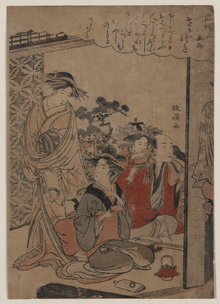Nagauta
Nagauta (長唄), literally "long song", is a kind of traditional Japanese music which accompanies the kabuki theater. It was developed around 1740. Influences included the vocal yōkyoku style used in noh theater, and instruments included the shamisen and various kinds of drums. The music is a combination of different styles stemming from the music popular during the Edo period.

Sake Cup by Santō Kyōden, 1783-1784, a meriyasu
The shamisen, a plucked lute with three strings, is a very popular instrument in nagauta. Nagauta performers generally play the shamisen and sing simultaneously.
Nagauta is the basis of the Nagauta Symphony, a symphony in one movement composed in 1934 by composer Kosaku Yamada.
Further reading
- William P. Malm, Nagauta: the heart of kabuki music (C. E. Tuttle, 1963) Internet Archive copy
gollark: BECOME yellow.
gollark: I know all information.
gollark: Next Saturday.
gollark: That's for apiomemetic reasons. Did you watch the apiospace video?
gollark: Anyway, please read/view those.
References
- Santō, Kyōden (1783). "Sake Cup". World Digital Library (in Japanese). Retrieved 28 May 2013.
- William P. Malm (1963). Nagauta: the heart of kabuki music. C. E. Tuttle Co. p. 17. Retrieved 28 May 2013.
This article is issued from Wikipedia. The text is licensed under Creative Commons - Attribution - Sharealike. Additional terms may apply for the media files.